For the last two weeks I’ve spent a lot of time testing and thinking about the Ixalan draft format. Last week I talked about the two-color archetypes. Today I want to go over the combat tricks. Being familiar with the combat tricks is important in any limited format, as one of the easiest ways to get blown out is to play into a combat trick that you could have anticipated.
White
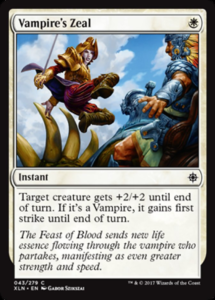
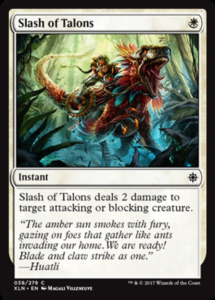
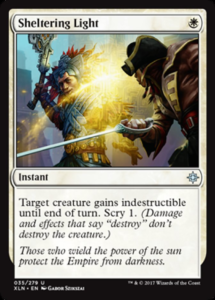
In Ixalan, white has access to three different one mana combat tricks, and they’re all quite playable. Vampire’s Zeal is a fine combat trick that get’s a little better in a Vampires deck. For this reason, if your opponent is on black-white Vampires, it’s slightly more likely that they have this card in their deck, as they should prioritize it a little higher than normal. If your opponent makes what looks like a chump attack, it’s likely that they have Vampire’s Zeal that they’re hoping to trade for your creature.
Slash of Talons is both a combat trick and a removal spell. It’s at its best in control decks, as it’s not very good at pushing through damage or clearing large blockers, which is what aggro decks typically look for in a combat trick. The important thing to remember when you suspect your opponent might have Slash of Talons is to not let them get a two-for-one with it. If they use Slash of Talons to get rid of your 2/2 it’s hardly the end of the world. But if you attempt to use a combat trick of your own, such as a pump spell to kill their 4/4, and they respond by playing Slash of Talons on your creature? That is going to put you significantly behind.
Sheltering Light is an uncommon, and thus you won’t see it as much. Most of the time it’s going to be used to save a creature that otherwise would have traded in combat, but it can also be used to protect your creatures from removal spells such as Vanquish the Weak and Contract Killing. A few times I have used it at the end of my opponent’s turn just to get a scry out of it and make sure I hit my land drops. It’s not a play I would make very often, but it’s nice to know that the option exists.
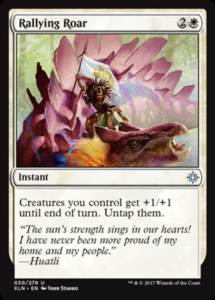
Rallying Roar is not as straightforward as the previously mentioned tricks, and it usually takes a little bit more effort to get the most out of it. However, it’s also has one of the highest ceilings with regards to power level, and can totally swing a game in its controllers favor by essentially creating multiple surprise blockers. For that to work however, you need to be able to safely attack with your creatures first. That’s usually easier said than done when your opponent also has a lot of creatures, so you will often have to settle for using Rallying Roar offensively to pump your creatures, while simultaneously untapping them to prevent a swing back.
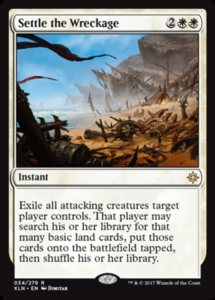
Settle the Wreckage is yet another card with a very high ceiling. Because it’s rare, you probably shouldn’t play around it as often; but that doesn’t mean you should play recklessly either. If you feel like you have the game locked up, losing all of your creatures to a Settle the Wreckage is one of the easier ways to lose, and you should probably play around it. Otherwise, it’s pretty safe to just hope that they don’t have it. Keep an eye out for this card while drafting. If you saw one going around, the chances that your opponent has one increase significantly.
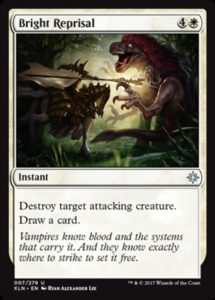
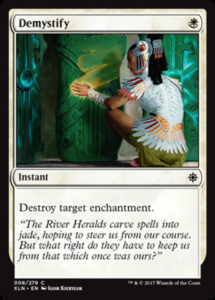
These last two aren’t combat tricks per se, but they can still screw things up for you in combat. Bright Reprisal is a removal spell that can only target attacking creatures. If you think your opponent has one you should consider if it’s better to not attack and force them to keep up mana again next turn, or tap out and let their shields down. Demystify is often brought in from the sideboard against white decks with lots of enchantment based removal. Most people will be happy to use Demystify right away to destroy a Pious Interdiction or Ixalan’s Binding, but if you wait until combat on your opponent’s turn you can potentially set up a two for one.
Blue
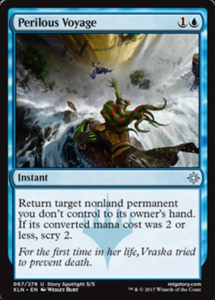
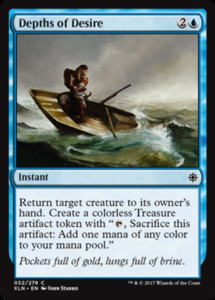
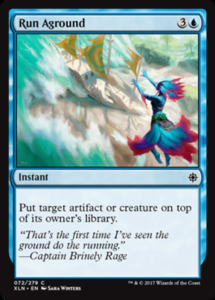
Blue is a very tempo oriented color in Ixalan, and that is reflected in the fact that color gets three different bounce spells, two of them at common. Ideally I prefer to use these offensively to get rid of opposing blockers and push through damage, but they work fine as defensive spells as well, especially if getting rid of a big attacker means you get to eat a smaller creature in combat. Since Depths of Desire can target your own creatures, it can also be used to save them from removal spells or in some cases get a second use out of an enters-the-battlefield ability.
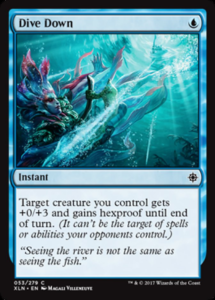
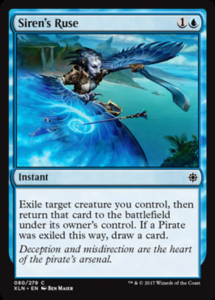
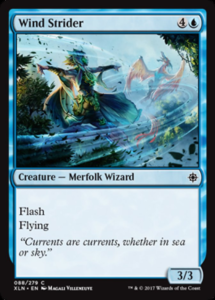
The main purpose of Dive Down is to protect your most important creatures from removal spells, but it can also be used to save a creature in combat. Siren’s Ruse is a nifty trick that lets you flicker one of your creatures and trigger any enters the battlefield abilities you might have. Because of the raid mechanic, it’s at its best when you’re attacking. A lot of the time, it will be used to save an attacking or blocking creature by removing it from combat. Therefore if your opponent attacks with multiple creatures and you suspect they might be holding Siren’s Ruse, consider blocking a creature without an etb-ability to force them to choose between saving their creature and getting a second trigger. Wind Strider is not really a combat trick, but it’s a creature with flash and as such something you should keep in mind when choosing how to attack.
Black
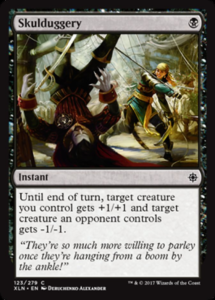
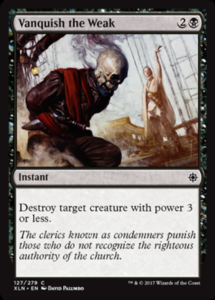
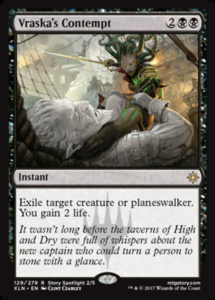
Black has many good removal spells, but only one actual combat trick. Skulduggery is a powerful trick that can be very punishing to those who do not play around it. There’s a fair amount of creatures with only one toughness. If you can use Skulduggery as a pump spell in combat and to kill an opposing one toughness creature you’ll be firmly ahead. It’s very important to play around Skulduggery by not letting your opponent set up such a devastating two-for-one play, especially in the early turns of the game.
Vanquish the Weak and Vraska’s Contempt are both instant removal spells, and as such they can be used to “get” you if you attempt a double block or try to use a pump spell in combat.
Red
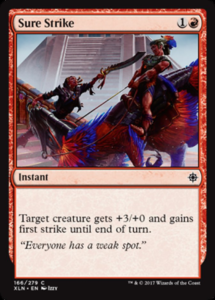
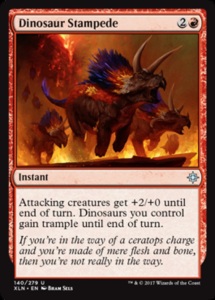
Red is a very aggressive color, and almost any red deck is going to want to be at least somewhat aggressive. Red’s combat tricks fit this theme very well, as they work best in aggressive strategies.Sure Strike is great for clearing out bigger blockers and getting ahead on tempo by letting you play multiple spells in a turn. Dinosaur Stampede is a powerful alpha strike type of card that works especially well in decks where you want to go wide. It’s important to keep in mind that you don’t need your creatures to be dinosaurs in order for it to be good. Giving your team +2/+0 is pretty good on its own, but it doesn’t hurt to have them gain trample either, especially against opposing chump blockers, such as 1/1 vampire tokens.
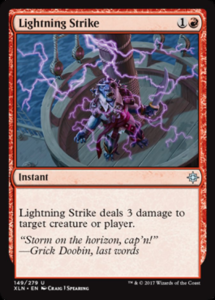
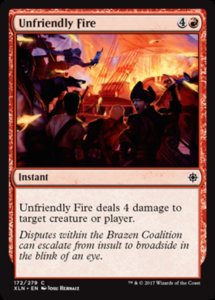
Red has two instant speed burn spells that can hit both creatures and players. In combat these work much like any other instant speed removal spells, with the difference that they can effectively be countered by your opponent’s pump spells. It can be tempting to wait until the last possible moment to use a removal spell, but when your removal is one of these you should consider using it on your turn instead so as to not walk right into Crash the Ramparts.
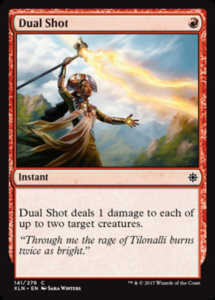
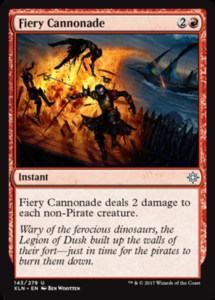
Dual Shot is a strong card out of the sideboard vs decks with lots of one toughness creatures. Most of the time you’re just going to use it as a removal spell, but I have seen it produce some pretty devastating blow outs in combat when combined with Bellowing Aegisaur. Fiery Cannonade can clear your opponent’s smaller creatures, and if you’re going to do that you might as well do it when they’re attacking to make their larger creatures a little easier to kill in combat. Just make sure you’re not playing into something like Rallying Roar by waiting.
Green
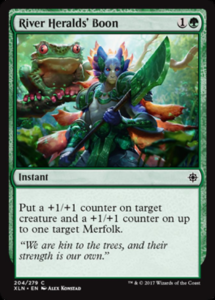
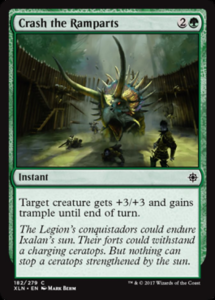
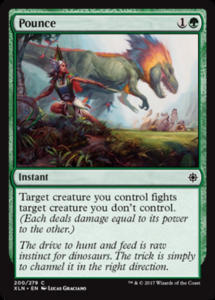
River Heralds’ Boon is the biggest payoff at common for playing Merfolk. The fact that you get to divide the counters as you choose means you can almost always set up a favorable trade with it, and leave an extra +1/+1 counter or two behind. I take this card pretty highly when drafting Merfolk, and I advise you to play around it when up against a Merfolk opponent, as they will almost assuredly try to draft as many copies as possible.
Crash the Ramparts is a fine pump spell, but not very efficient at three mana. Still, it’s a decent card, and I’ll play it in most of my green decks. The fact that it gives the creature trample is a very nice bonus when you’re trying to pressure your opponent’s life total. Likewise, when you’re the one on defense, remember that chump blocking isn’t going to cut it versus Crash the Ramparts.
Green also gets one removal spell at instant speed, and it’s a pretty good one! Green tends to have a fair amount of large creatures, so Pounce will often be a two mana spell that can kill any creature on the board. Unlike other removal spells however, it can be effectively countered if your opponent responds with a removal spell of their own.
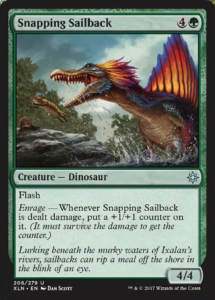
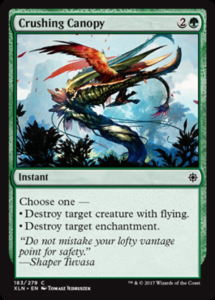
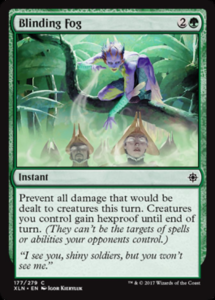
Snapping Sailback is yet another flash creature, and this one is really good. If you manage to play it as a surprise blocker and eat a creature you just paid five mana for a 5/5 that also killed on of your opponent’s creatures, and that’s a very good deal. The problem is that it will often be obvious to your opponent when you have it, as passing with five mana open on turn five for example looks a little suspicious.
Crushing Canopy is a fine sideboard card that sometimes even makes the maindeck. I’ve lost a few games that I thought I was pretty sure I was going to win to the plummet effect, and the fact that it also hits enchantments means you don’t have to worry as much about it being stranded in your hand due to a lack of targets. The thing about creatures with evasion is that you’re often counting on them getting through for damage, so if one gets tagged by a removal spell it can really mess up your combat math.
I’ve yet to see anyone actually play with Blinding Fog. I think it’s just too inefficient and its uses too narrow to make it worth it.
Hopefully after reading this article you feel a little more familiar with the tricks of Ixalan, and a little more prepared to play both with and against them in the future. Failing to play around a combat trick when you ought to have done so can easily cost you the game. Better then to take a few extra seconds to consider the cards that might be in your opponent’s hand—and how to play around them.
Until next time!
Sandro is a Magic player from Stockholm, Sweden. He’s been playing Goblins in Legacy for years. Follow him on Twitter @SandroRajalin

